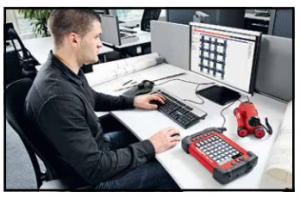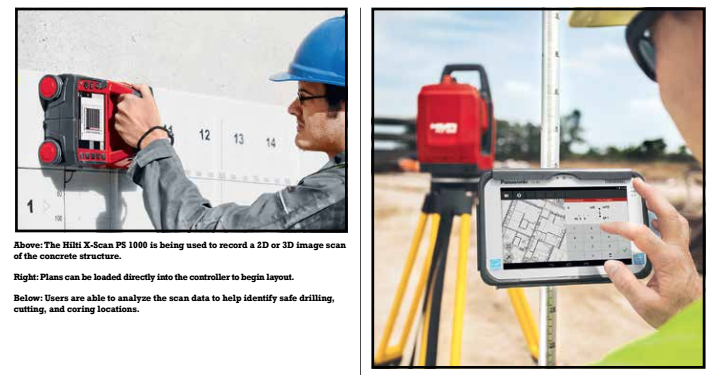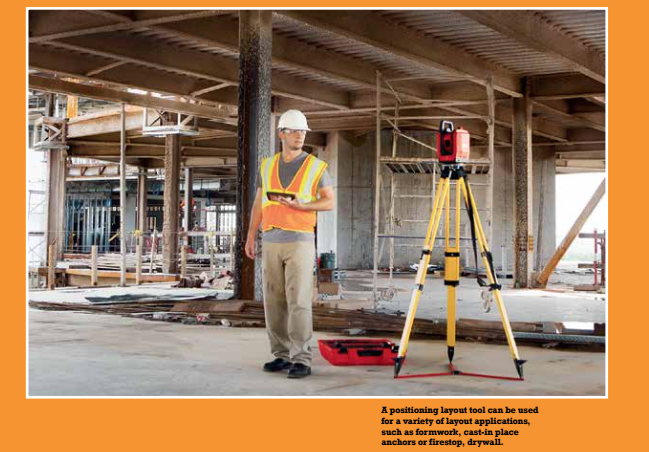High-tech tools for construction surveying can also be used by land surveyors and new surveyors.
By Jeff Salmon
 Construction, both residential and commercial, is the second-largest industry in the world–surpassed only by agriculture. From site plans and stakeouts to as-built surveys and, now, BIM, construction has and will continue to provide a major market for surveyors. 2017 looks promising for this space.
Construction, both residential and commercial, is the second-largest industry in the world–surpassed only by agriculture. From site plans and stakeouts to as-built surveys and, now, BIM, construction has and will continue to provide a major market for surveyors. 2017 looks promising for this space.
Dodge Data and Analytics, a provider of research intelligence for the North American construction industry, has released its 2017 Dodge Construction Outlook. The report predicts that new construction starts in 2017 will increase 5% to $713 billion for North America, compared to an estimated 1% in 2016, a significant increase.
Anecdotally, in my corner of the world (the Denver, Colorado, metro area) construction sites are sprouting up like proverbial mushrooms after a rainstorm. Driving by worksites, one cannot help but spot the ubiquitous logo of construction equipment giant, Hilti Corporation.
Founded in 1941 by Martin and Eugen Hilti, the firm is headquartered in Schaan, Liechtenstein and operates worldwide with nearly 20,000 employees in more than 120 countries. Beyond construction, Hilti serves a wide range of industries, including civil engineering, energy, and mining. Its products and systems include powder-actuated fastening, drilling and demolition, diamond coring and cutting, firestop systems, screw fastening, adhesive and mechanical anchoring, strut and hanger systems, and, of interest to surveyors, measuring instruments.
I talked to Annika Ensrud, business unit manager of Hilti USA, about the firm’s products that surveyors practicing in the construction field might find intriguing.
xyHt: We’ve seen a big trend towards the “digital worksite,” that is, the increasing digitization of construction processes to yield major improvements in efficiency, productivity, and, thus, profitability. What is Hilti’s approach to this trend?
Annika Ensrud: We have seen the same trend and are focusing our development and offerings on providing products, services, and software solutions that improve our customers’ productivity as they transition into this digitization of the construction processes.
xyHt: Hilti offers both robotic and manual total stations. For land surveying firms that perform construction and land surveying projects, are these total stations suitable for conventional land surveying applications as well?
Ensrud: Yes, they are. Our primary focus is to offer total stations to the construction industry. Hilti developed the total stations–and its software and user interfaces–using construction language and applications in order to make this technology accessible and easy to adopt by our contractors that are not typically surveyors by trade.
xyHt: What is the imaging technology behind your PS 1000 X-Scan and PS 250 Ferroscan systems?
Ensrud: The Hilti X-Scan PS 1000 is based on radar technology, which allows the user to detect reinforcing bars, pre- and post-tensioning cables, metal pipes, plastic pipes, electric cables, and glass-fiber cables in concrete up to 18 inches. Scan results are presented on the X-Scan display in 2D for immediate analysis or can be transferred to the Monitor PSA 100 for viewing in 2D and 3D for further evaluations.
The Hilti Ferroscan PS 250 provides a non-destructive means of locating reinforcing bars and measuring their depth of concrete cover. It can also estimate the diameter of detected rebar. The PS 250 is based on magnetic induction technology; thus the scanner can locate rebar accurately and reliably within concrete structures.
xyHt: Can imagery captured from these devices be integrated into 3D scanning software?
Ensrud: The results of scans are displayed on the portable monitor unit as easily interpretable 2D images. We can assign coordinates to the scan that can be imported into a BIM model. Later, safe drilling locations can be identified on previously recorded scans, and they can be laid out again using the total station. Integration of the scan data in 3D software is possible using Hilti PROFIS Layout, AutoCAD, Revit, Tekla, SketchUp, or BIM programs. Construction
Surveying Options
As Ensrud has detailed, Hilti has several surveying and inspection instruments that surveying professionals can use to accomplish a wide range of tasks. For construction layout, the firm offers two robotic and two manual total stations that can be also used for land surveying tasks.
Notably, Hilti has designed these total stations for accessibility and ease of use by the non-surveyor; this could be helpful for surveying firms integrating new employees into field crews.
Inspection and BIM are growing fields for the surveying profession, and Hilti’s PS 1000 X-Scan and PS 250 Ferroscan systems should be of interest to surveyors pursuing these opportunities. While most of us are familiar with handheld 3D scanners, to have one that can see through concrete is extraordinary. Couple this with the fact that data from these scanners can be imported into 3D modeling and BIM software programs, and we are well on the way to providing “X-ray” as-built and BIM surveys. How cool is that!?


